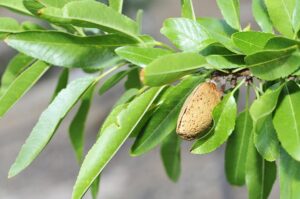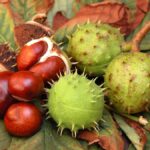There are two types of almonds: one sweet and one bitter. The sweet almond is the one you will use in the kitchen. The bitter almond is strongly flavored and is used to flavor extracts after being processed to remove a toxic acid.
Sweet almonds can be found blanched or not, whole, sliced or slivered, chopped, candied, smoked, and in paste form. The mild flavor of almonds complements almost every kind of food. You can add almonds to cereals, salads, cakes, cookies, pastries, and ice cream. Whole, split, or ground almonds can be served with fish, chicken, and vegetables.
Favorite almond recipe
English Peas, Spring Onions, and Roasted Almonds

How to choose almonds
Almonds still in their shells will not spoil quickly. When choosing shelled almonds, look for almonds that are uniform in color and that are not limp or shriveled. Almonds sold with their papery skin intact are called natural almonds. Almonds that have had the skin removed are called blanched almonds. A fresh almond will smell sweet and nutty.
How to store almonds
Unshelled almonds can be kept in a cool, dark, dry place. Shelled almonds can be placed in a plastic bag and stored in the refrigerator or freezer for up to 6 months.
How to blanch almonds
Blanching will remove the thin layer of brown skin that surrounds the seed. Plunge the almond into boiling water for 2 to 3 minutes. When the skin starts to swell, rinse the almonds under cold water, then remove the skin by pinching the almonds between your thumb and finger.
How to roast almonds
Place a single layer of almonds on a baking sheet. Heat them in the oven to 350°F (175°C) until they turn golden brown. Turn and stir them to ensure that they are evenly roasted. The time to roast will vary depending on the size of the almonds. Remove the almonds from the oven and place them in a container to cool.
About almonds
Almonds originated in Asia and North Africa, and the almond tree—which resembles a peach tree—can grow as high as 20 to 30 feet (6-9 m) tall. Because the almond is very sensitive to cold, the tree thrives in the Mediterranean-climate regions of Europe, Australia, South America, and California.
The fruit of the almond contains an oval, off-white seed that is covered with brownish skin. The shell itself is covered with a tough, fibrous green husk that breaks open when the fruit is fully mature.
Articles of interest:
Best Herbs for Container Growing
Garden Planning Books at Amazon:
- Vegetable Garden Almanac & Planner
- Kitchen Garden Grower’s Guide Vegetable Encyclopedia
- Vegetable Garden Grower’s Guide
- Tomato Grower’s Answer Book
More kitchen tips:
Bring your harvest to the table. Kitchen prep tips and easy recipes for the vegetables you grow. Click below for vegetable prep and recipes you can use now.
- Almonds
- Apples
- Apricot
- Aprium
- Artichoke
- Arugula
- Asparagus
- Avocado
- Bamboo Shoots
- Banana
- Basil
- Beans, Dried
- Beans. Long
- Beans, Shell
- Beans, Snap
- Beets
- Bitter Melon
- Blackberry
- Bok Choy
- Broccoli
- Broccoli Raab
- Brussels Sprouts
- Cabbage
- Cardoon
- Carrots
- Cauliflower
- Celeriac
- Celery
- Chard
- Chayote Squash
- Cherimoya
- Cherries
- Chestnut
- Chickpea
- Chinese Cabbage
- Chives
- Cilantro
- Citron
- Clementine
- Collards
- Coriander
- Corn, Sweet
- Corn, Baby
- Corn Salad, Mache
- Cranberry
- Cress
- Cucumber
- Daikon
- Dandelion
- Dill
- Eggplant
- Endive, Belgian
- Endive and Escarole
- Fava Beans
- Fig
- Florence Fennel
- Garlic
- Ginger
- Grapefruit
- Grapes
- Guava
- Horseradish
- Jerusalem Artichoke
- Jicama
- Jujube
- Kale
- Kiwifruit
- Kohlrabi
- Kumquat
- Leeks
- Lemongrass
- Lemons
- Lettuce
- Lime
- Mache (Corn Salad)
- Mandarin Orange
- Mango
- Maple Syrup
- Marjoram
- Melons
- Michihili
- Mint
- Mizuna
- Mushrooms
- Mushrooms, Cremini
- Mustard Greens
- Napa Cabbage
- Nectarine
- Okra
- Olives
- Olive oil
- Onions
- Oranges
- Oregano
- Parsley
- Parsley Root
- Parsnips
- Passion Fruit
- Pawpaw
- Peaches
- Pears
- Peas, Garden Snap
- Peas, Snow
- Pei Tsai
- Peppers, Chili
- Peppers, Sweet
- Persimmon
- Pineapple
- Pineapple Guava
- Plantain
- Plums
- Pluots
- Pomegranate
- Potatoes
- Prickly Pear
- Pumpkin
- Quince
- Radicchio
- Radishes
- Raspberries
- Rosemary
- Rhubarb
- Rutabaga
- Sage
- Salsify
- Sauerkraut
- Savory
- Shallots
- Sorrel
- Spinach
- Squash, Summer
- Squash, Winter
- Strawberries
- Sunchokes
- Sunflower
- Sweet Potato
- Swiss Chard
- Tangerine
- Taro
- Tarragon
- Thyme
- Tomatillo
- Tomato
- Turnip
- Turnip Greens
- Yams















